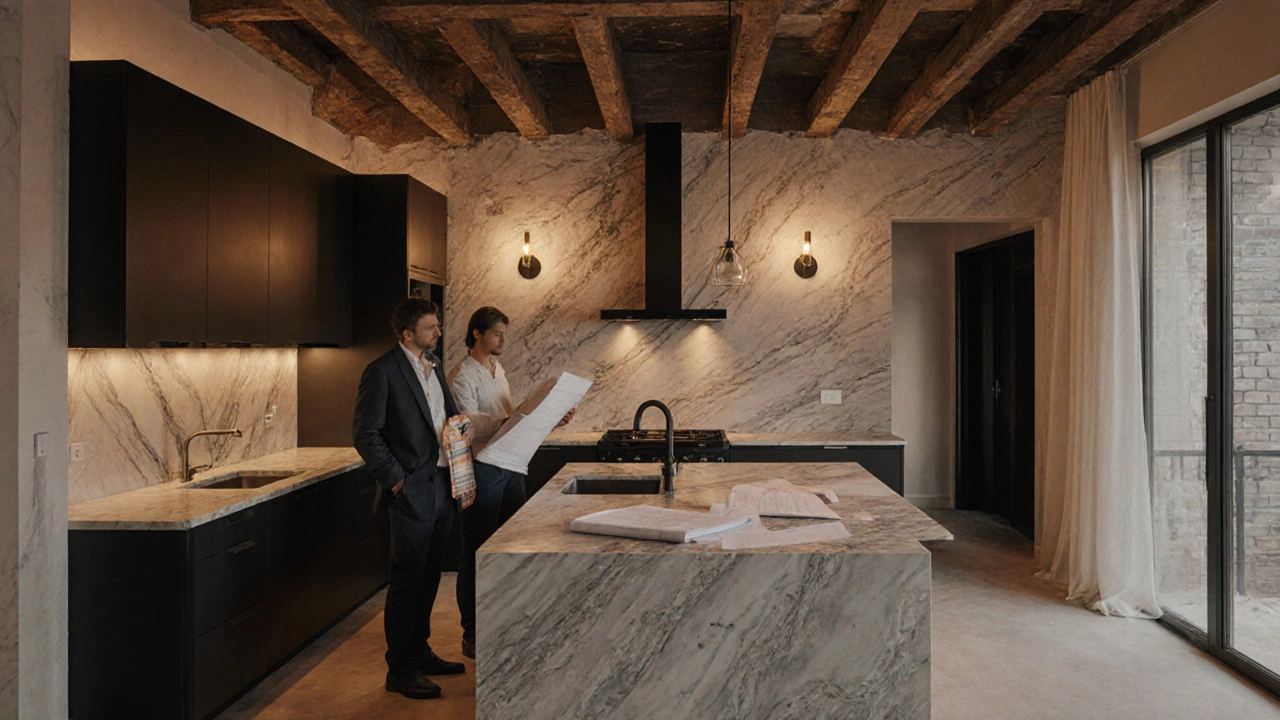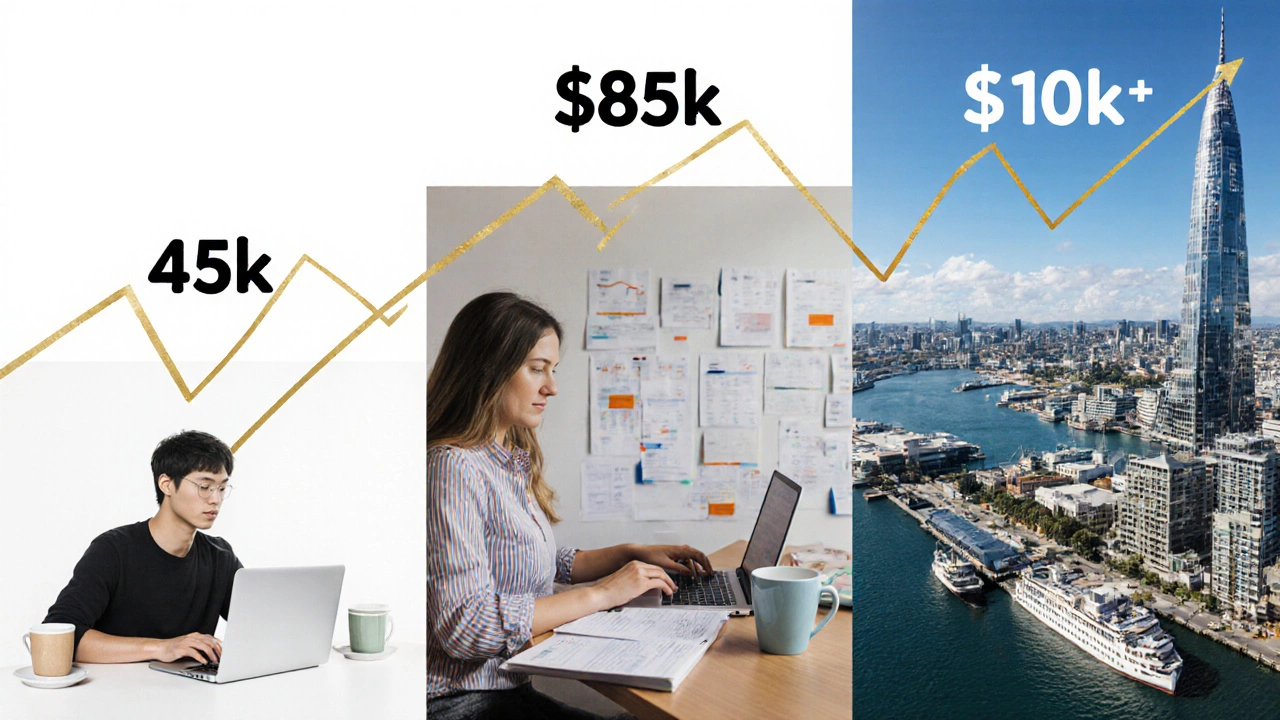How Much Do Interior Designers Really Earn? Salary Truths in 2025

Interior Designer Salary Calculator
Your Experience Level
Payment Model
Project Details
Estimated Annual Income
Based on your inputs:
-
-
Your estimated annual income is:
💡 Key insight: The most successful designers charge $120+/hour or focus on high-value projects with clear contracts. Undercharging for projects attracts low-budget clients and limits growth.
Ever scrolled through Instagram and seen a stunning living room transformation, then wondered - how much do interior designers actually make? It’s not just about picking velvet sofas and matching throw pillows. Behind every beautifully styled space is a business, a client list, and a paycheck that can vary wildly. Some designers make six figures. Others struggle to cover rent. The truth? There’s no single answer - but there are clear patterns.
What Interior Designers Actually Do
Before we talk money, let’s clear up what interior designers actually do. It’s not the same as decorating. A licensed interior designer works with building codes, structural changes, lighting systems, and accessibility standards. They handle permits, coordinate with contractors, and manage timelines. Many start with a degree in interior design, then spend years building a portfolio. Others jump in with a knack for space and style, then learn the rest on the job.
In New Zealand, you’ll find designers working across residential homes, boutique hotels, rental apartments, and even small commercial spaces like cafés or yoga studios. Some focus on luxury clients with budgets over $200,000. Others take on modest renovations for first-time homeowners. The work varies - and so does the pay.
How Interior Designers Get Paid
There are three main ways designers earn:
- Hourly rates - $50 to $150 per hour, depending on experience and location. In Auckland, a mid-level designer might charge $85/hour.
- Flat fees - a fixed price for a full project, like $5,000 for a living room redesign. This works well for clients who want clear budgets.
- Percentage of project cost - 10% to 20% of the total materials and labor. If a client spends $80,000 on a kitchen renovation, the designer could earn $8,000 to $16,000.
Some designers also earn commissions from furniture and lighting suppliers. That’s not unethical - it’s common. But good designers disclose it upfront. Clients appreciate transparency.
Typical Earnings by Experience Level
Here’s what most designers in New Zealand earn in 2025, based on industry surveys and real client data:
- Entry-level (0-3 years): $45,000-$60,000 per year. Many work part-time or freelance while building a client base.
- Mid-career (4-8 years): $70,000-$95,000. These designers have repeat clients, referrals, and often run their own small firms.
- Senior/established (9+ years): $100,000-$180,000. They may lead teams, design for high-end developments, or license their own product lines.
Top-tier designers in Auckland or Wellington who work with luxury real estate developers can hit $250,000+ annually. But those are exceptions. Most earn between $60,000 and $120,000.

Why Some Designers Struggle to Make Money
Not every designer thrives. Many burn out because they underprice their work. A common mistake? Charging $30/hour because they think it’s "competitive." But that’s below minimum wage after you factor in software, travel, admin, taxes, and health insurance.
Others take on too many small jobs - $1,500 for a bedroom layout here, $800 for a color palette there - and never scale up. They’re busy, but not profitable. The ones who succeed learn to say no. They focus on projects with real budgets and clear scope.
Marketing is another hidden cost. Building a website, running Instagram ads, attending design fairs - it all adds up. One designer in Christchurch told me she spends $1,200 a month just on content creation and SEO. That’s part of her overhead.
Where the Real Money Is
Designers who make the most money don’t just pick furniture. They solve problems. They help clients sell homes faster by staging them for the market. They partner with builders to design custom homes from the ground up. They create cohesive brands for boutique hotels.
The biggest earners often work with:
- Real estate developers on multi-unit apartment buildings
- Property managers who need consistent, cost-effective designs for rentals
- Architects on high-end residential projects
- Hotels and short-term rental operators (Airbnb hosts with 5+ properties)
One designer in Auckland told me she earns 70% of her income from repeat clients in the short-term rental space. She designs 12 apartments a year, all with the same modern, durable style. Each project nets her $12,000. That’s $144,000 a year - with no cold calling or chasing new clients.

How to Build a Lucrative Interior Design Business
If you’re thinking about becoming a designer, here’s what actually works:
- Specialize - Don’t do everything. Focus on one niche: kitchens, rentals, heritage homes, or eco-friendly design.
- Package your services - Offer "Design in a Box" - a fixed-price package with mood boards, shopping lists, and layout plans. Clients love predictability.
- Charge what you’re worth - If you’re spending 20 hours on a project, don’t charge $50/hour. Charge $120. Your time is valuable.
- Use contracts - Always. No exceptions. Even for friends. A simple one-page agreement protects you from scope creep and unpaid invoices.
- Build relationships with suppliers - Get trade discounts. Pass savings to clients. Keep the margin for yourself.
One designer in Wellington started by redesigning her own apartment. She posted before-and-after photos on Instagram. A local real estate agent saw it, hired her to stage three homes. Within two years, she was booked out six months ahead. She didn’t run ads. She just did great work - and let it speak.
Is Interior Designing Worth It?
Is it worth it? That depends on what you want.
If you want a 9-to-5 with benefits, this isn’t it. Most designers are freelancers. There’s no paid leave. No pension. You pay your own taxes. You deal with clients who change their minds on a Friday night.
But if you love creativity, problem-solving, and building something tangible - and you’re willing to treat it like a business - then yes. It can be incredibly rewarding. The money isn’t guaranteed, but it’s absolutely possible. And unlike many creative fields, interior design has a clear path to profitability.
There’s no magic formula. Just hard work, smart pricing, and the courage to stop undercharging. The best designers aren’t the ones with the fanciest portfolios. They’re the ones who know their worth - and don’t apologize for it.
Do interior designers make good money in New Zealand?
Yes, but it depends on experience, niche, and how you structure your business. Most mid-level designers earn between $70,000 and $95,000 a year. Senior designers or those working with developers can earn $150,000 or more. Entry-level designers often start at $45,000-$60,000, but many work part-time while building their client base.
Is interior design a stable career?
It’s not stable in the traditional sense - there’s no guaranteed paycheck every two weeks. But it’s sustainable if you treat it like a business. Designers with strong systems, repeat clients, and clear contracts thrive. Those who rely on one-off gigs or undercharge often burn out. Stability comes from consistency, not luck.
Can you become an interior designer without a degree?
Yes, you can start without a degree. Many successful designers in New Zealand are self-taught. But if you want to work on structural changes, pull permits, or call yourself a "licensed interior designer," you’ll need formal qualifications. For residential styling and decorating, experience and a strong portfolio matter more than a diploma.
How do interior designers find clients?
Most find clients through referrals, Instagram, and partnerships. Real estate agents, builders, and property managers often hire designers for staging or renovation projects. A strong portfolio on Instagram or a website with before-and-after photos is essential. Many designers also attend local design expos or collaborate with furniture stores to get exposure.
What’s the biggest mistake new designers make?
Undercharging. Many new designers price themselves too low because they’re afraid they won’t get clients. But low rates attract low-budget clients and make it harder to raise prices later. It also devalues the profession. Charging fairly from the start builds credibility and attracts better clients.
